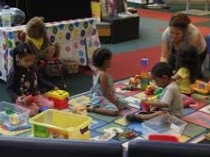The first thing we are going to do before entering fully into the meaning of the term toy library is to know its etymological origin. In this case we have to state that it is the result of the sum of two lexical components of different origins. Exactly it has been formed by joining the Latin word "ludus", which can be translated as "game", with the Greek "teca", which is synonymous with "place where there is" or even "box".
 A toy library is a recreation place that has toys and games . Generally it is a space where children can have fun, using the items stored there.
A toy library is a recreation place that has toys and games . Generally it is a space where children can have fun, using the items stored there.
The toy libraries were born as pedagogical spaces . At the level of early childhood education, they are used to stimulate children and to teach them various values (the importance of sharing, solidarity, etc.).
Many parents do not hesitate to take their children to a play center periodically. They do it because they are aware of the advantages that these spaces bring with them. We are referring to benefits such as these:
-They allow the little ones to develop their social skills, as they give them the opportunity to meet other children and establish relationships of friendship and equality with them.
-They are great so that minors can improve significantly from their ability to cooperate to their creativity, including their ability to make decisions.
-They learn basic values such as respect, tolerance and education in play libraries. Not to mention that they also learn to tidy up, take care of their toys and even not to make a mess.
-In the same way, another of the great advantages of these spaces is that they are very useful so that children can develop or improve their artistic skills, whether in music, painting or even dance, for example. .
There are also play centers for people of all ages. There are play centers that operate in community centers, hospitals and prisons, for example. The goal is to take advantage of the pedagogical potential of the game.
According to their characteristics , therefore, it is possible to differentiate between school toy libraries , hospital toy libraries , itinerant toy libraries and public toy libraries , among others.
On a general level, beyond the differences according to the age of the users, the toy libraries contain elements that allow the imagination to develop and promote concentration. Of course, in the case of children's play libraries, toys must not contain toxic substances or have sharp edges or points that could put children at risk. It is the way that exists to guarantee the safety and well-being of these minors.
Board games, building blocks, plasticine, books , puzzles , musical instruments and balls are some of the most common items that are usually present in toy libraries.
